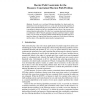Free Online Productivity Tools
i2Speak
i2Symbol
i2OCR
iTex2Img
iWeb2Print
iWeb2Shot
i2Type
iPdf2Split
iPdf2Merge
i2Bopomofo
i2Arabic
i2Style
i2Image
i2PDF
iLatex2Rtf
Sci2ools
CPAIOR
2005
Springer
2005
Springer
Shorter Path Constraints for the Resource Constrained Shortest Path Problem
Abstract. Recently, new cost-based filtering algorithms for shorter-path constraints have been developed. However, so far only the theoretical properties of shorter-path constraint filtering have been studied. We provide the first extensive experimental evaluation of the new algorithms in the context of the resource constrained shortest path problem. We show how reasoning about path-substructures in combination with CP-based Lagrangian relaxation can help to improve significantly over previously developed problem-tailored filtering algorithms and investigate the impact of required-edge detection, undirected versus directed filtering, and the choice of the algorithm optimizing the Lagrangian dual.
Cost-based filtering Algorithms | CP-based Lagrangian Relaxation | CPAIOR 2005 | Shorter-path Constraint |
| Added | 26 Jun 2010 |
| Updated | 26 Jun 2010 |
| Type | Conference |
| Year | 2005 |
| Where | CPAIOR |
| Authors | Thorsten Gellermann, Meinolf Sellmann, Robert Wright |
Comments (0)

